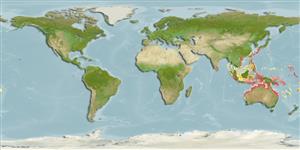Teleostei (teleosts) >
Callionymiformes (Dragonets) >
Callionymidae (Dragonets)
Etymology: Callionymus: Greek, kallion, comparative of kallos = beautiful + Greek, onyma = name; with a better name.
Eponymy: Major George Gross (d: 1909) was an amateur natural historian, at one time Consul for Switzerland and also a schoolmaster for twenty-four years teaching German (1886) at Brisbane Grammar School, Queensland. [...] (Ref. 128868), visit book page.
More on author: Ogilby.
Environment: milieu / climate zone / depth range / distribution range
Ecology
Marine; demersal; depth range 13 - 32 m (Ref. 75992). Tropical
Eastern Indian Ocean: northwestern Australia.
Size / Weight / Age
Maturity: Lm ? range ? - ? cm
Max length : 20.0 cm TL male/unsexed; (Ref. 3132)
Dorsal spines (total): 4; Dorsal soft rays (total): 9; Anal soft rays: 7. Ground coloration dark brown or grey, ventral parts of body yellowish. Sides of body with a row of dark blotches. First dorsal fin light, anterior margin dusky, with 3 to 5 oblique white dark-edged stripes consisting of spots and lines. Second dorsal fin, caudal fin, pectoral and pelvic fins with darkish spots. Anal fin colourless. Base of first dorsal fin 0.8 to 0.9 times in head length (Ref 42832).
Inhabits trawling grounds, generally on sand bottoms.
Life cycle and mating behavior
Maturity | Reproduction | Spawning | Eggs | Fecundity | Larvae
Allen, G.R. and R. Swainston, 1988. The marine fishes of north-western Australia: a field guide for anglers and divers. Western Australian Museum, Perth. 201 p. (Ref. 3132)
IUCN Red List Status (Ref. 130435: Version 2024-2)
Threat to humans
Harmless
Human uses
Fisheries: bycatch
Tools
Can't connect to MySQL database fbquizv2. Errorcode: Too many connections
